The Shift in Sales & Marketing
What homeowners expect in an “Amazon Prime” world.
Guest Blog Post Contributor: Jeff Wraley, Founder & CEO of Groundwork
Long before the COVID-19 shut downs in early 2020, consumer behavior had been shifting to rely on digital buying experiences. There’s actually a term for it: “Amazonification.”
When you hear homeowners say “Can you get the project done before next week?” or “Can you just tell me how much you think it will be over the phone?” you are seeing Amazonification in action.
Homeowners aren’t the bad guys here though. The truth is that we all have changed our expectations for delivery time and ease of use for the products and services we need. All signs point to this trend continuing. A Microsoft study reported that the human attention span is only 8 seconds, a sharp decrease from 12 seconds in 2000, just about the time the internet and smartphones became prominent.
So what can contractors do to counteract or even leverage the trends we see in consumer behavior? To start, let’s take a look at how advertising strategies have evolved for some clues.
The Difference Between Features and Benefits:
The standard marketing tactics from the 40’s through the 90’s relied heavily on features. Features of a product are things like, the number of blades a razor has, or the smaller, more compact size of a newly released cell phone. For service businesses, features are things like how long the company has been in business, a list of services the business provides, or even the level of responsiveness the business maintains. These are all characteristics about the business.
The innovations of the past 20 years have allowed consumers to become more self-involved. The result is higher expectations for convenience. Additionally, shopping based on features has become increasingly exhausting due to the plethora of options available to anyone with an internet connection.
As a result, focusing on benefits – how your service improves your customer’s life, instead of features has become the new gold standard in sales and marketing. The difference is subtle so here are some examples:
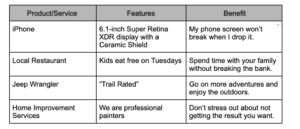
Translating Benefits to Each Customer
Understanding the specific benefits of your services for each client is much more nuanced than you may expect. Each customer has a slightly different reason for calling you. They are looking to make some improvements around their house, sure, but that really isn’t their goal. Their goal is something more personal than that.
Introduction to the “Jobs-to-be-Done” Theory
When a homeowner calls any sort of home improvement contractor, they aren’t necessarily excited about the type of paint you might use, the names of the people on the crew, the processes you use, etc. They are looking to accomplish something. They have a “Job” that needs to be done.
Jobs-to-be-Done is a theory grown out of Harvard business school and popularized by Clayton Christensen and Anthony Ulwick. The goal of the framework is to get to the real, personal problem (job) that a consumer is looking to solve. In the home improvement context, the “Job” might be a subconscious desire to keep up with the “Jones'”. Or, it may be a desire to make their home feel more like their last one. Or maybe they have developed stress over finishing several projects around the house prior to bringing a new baby into the house. In these cases, the homeowner isn’t hiring you to complete a project, they are hiring you to make them look better, feel more comfortable in their home, or reduce stress before a monumental change in their family life.
The more you can uncover the actual job that your prospect wants you to do, the more you will be able to cater your sales approach to gain a happy customer.
So how can your sales processes uncover these “jobs” – and especially in an environment where consumers are looking for quick results and convenient interactions?
Consider this series of graphs.
- Line 1 represents slowly gaining knowledge of the customer.
- Line 2 represents a more moderate pace of gaining knowledge of the customer.
- Line 3 represents quickly gaining knowledge of the customer.
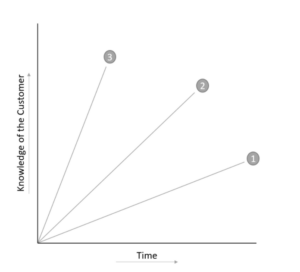
Now, let’s draw a horizontal line on the graph to represent understanding the customer’s “Job to be Done”
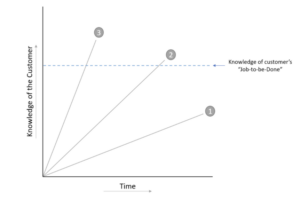
Now let’s compare the areas under the three lines. The area represents the amount of time and effort it takes to reach the point of understanding the Job to Be Done. The smaller the area, the less expensive it is to service the lead.

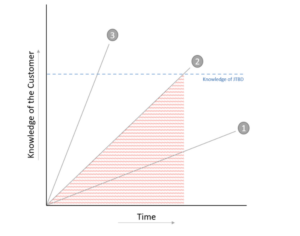
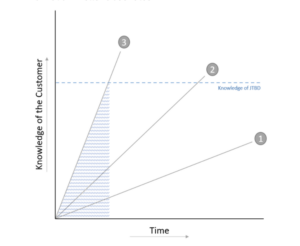
The idea behind these graphs is that speeding up the discovery process with your customers is not only what they are looking for, but it can save time, money, and frustration in your sales process.
So, how do you uncover customer goals and speed up the discovery process and quickly build trust with prospects?
Here are a few tips:
1. Structure your sales process to understand the unique situation of each customer instead of talking about the features of your business or service.
Asking good questions is the hallmark of a good salesperson. Consider asking “When did you first start thinking about this project?” This question gets them talking about their mental state. Asking a few follow on questions based on their answers can help uncover the “job” they are looking to get completed.
2. Adopt a help-first mindset. Customers who feel like you can help them, and trust you, will buy from you. Customers who think you are trying to “sell” are less likely to sign on the dotted line. When asking personal questions, the more genuine you are, the more trust you will build. As consumers, we have been trained to smell what Josh Braun calls “Commission breath” and it is a sure-fire way to turn off a prospect. Do the work to find the “job” that prospect is trying to accomplish, provide them some information on how you can help them reach their goal, and then detach from the outcome of the conversation and let the prospect buy – don’t “sell.”
3. Lastly, leverage technology to establish a customer focused communication strategy – it can be a huge asset in the sales process. To create a customer experience that today’s homeowners will appreciate, you must establish these three things.
-
- Convenience – Text-based communication is (data) more likely to be responded to than a voice mail. Zoom and other virtual tools are very affordable and can help you provide convenience to your customers and your sales team.
- Responsiveness – Many CRMs and communication tools offer reminders and alerts for reaching out to customers. Take advantage of these features to ensure your sales teams are keeping up with prospects. Consider setting a goal for responsiveness and reviewing that goal in individual check-ins and as a company.
- Transparency – Consumers have more information at their fingertips than ever before. A savvy consumer will fact check you, especially if they sense you are not being transparent. Develop a list of links to share with your prospective customers. These could be links to your own content, or links to other reputable sources of info (bonus points for linking to other sources – it feels less sales-ey!).
To learn more about GroundWork and the work Jeff Wraley and his team are doing, check out https://www.hellogroundwork.com/
![]()

